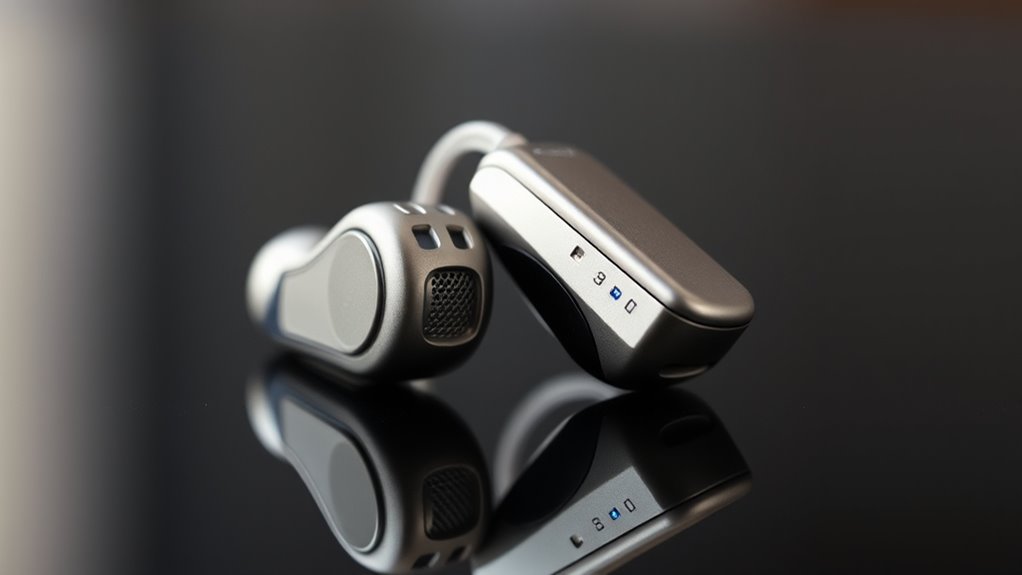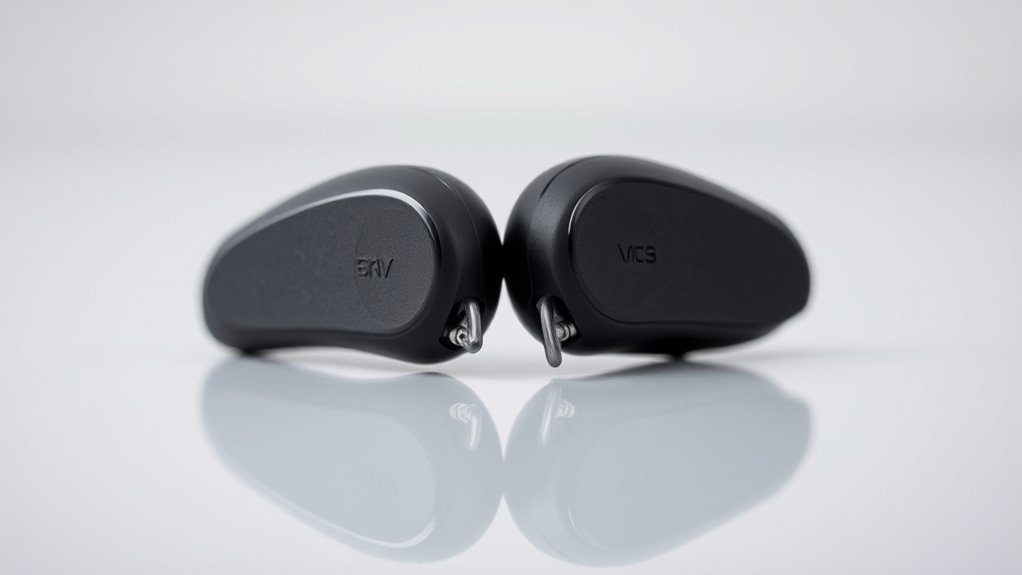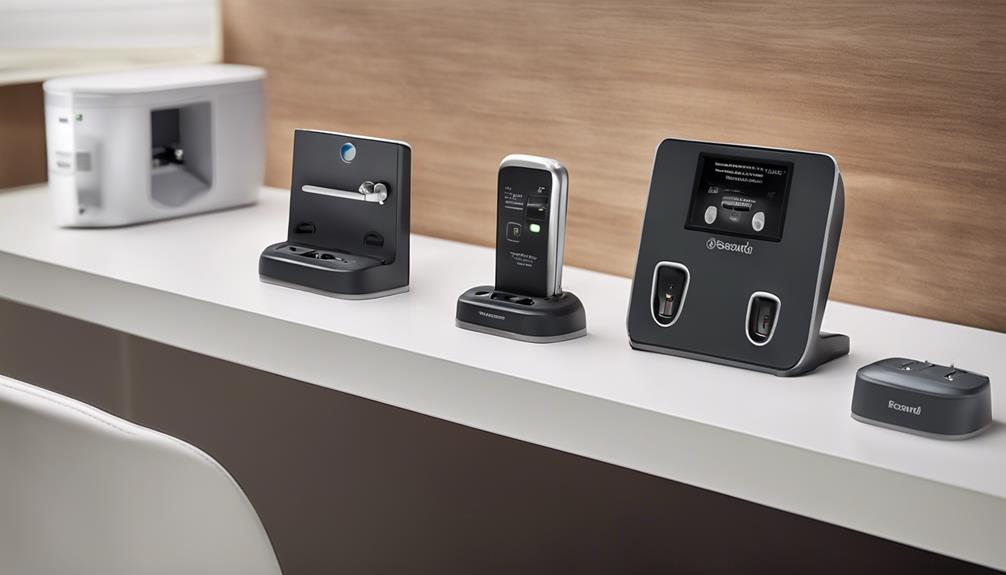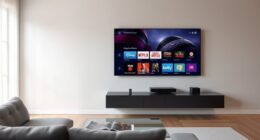Binaural synchronization allows your hearing aids to communicate wirelessly in real time, sharing sound data instantly through protocols like Bluetooth or proprietary wireless technology. This coordination helps your devices work together to deliver natural sound, improve localization, and reduce background noise. They stay synchronized by continuously updating sound information, ensuring seamless and coherent hearing experiences. If you want to discover how this technology keeps your listening smooth and natural, there’s more to uncover beyond this.
Key Takeaways
- Hearing aids communicate wirelessly via protocols like Bluetooth or proprietary systems to share sound data instantly.
- They synchronize signals in real-time to maintain aligned audio cues and reduce delays or mismatches.
- Wireless data sharing enables the aids to coordinate binaural cues, improving sound localization and speech clarity.
- Continuous updates and advanced algorithms ensure seamless, low-latency communication between devices.
- Device design and synchronization technology work together to create a unified, natural hearing experience.
Understanding Binaural Synchronization Technology

Binaural synchronization technology works by aligning sound signals played separately to each ear to create a unified auditory experience. This process enhances your auditory perception by ensuring both ears receive coordinated signals, which your brain then combines seamlessly. When your devices synchronize, they facilitate neural integration, allowing your brain to process sounds more naturally and accurately. This synchronization reduces delays or mismatched signals that could distort sound quality or cause confusion. As a result, you experience clearer speech, better localization of sounds, and an overall more natural hearing environment. By promoting synchronized input, binaural technology helps your brain interpret complex auditory information more efficiently, improving your ability to understand conversations and environmental sounds, even in noisy settings. Additionally, high-quality audio synchronization is essential for achieving optimal binaural performance and a truly immersive listening experience.
How Hearing Aids Communicate in Real-Time

Your hearing aids communicate in real-time using wireless data sharing, allowing them to exchange sound information instantly. Synchronization technology guarantees both devices stay aligned, providing seamless hearing experiences. Adaptive sound processing then adjusts to your environment, making sure you hear everything clearly and naturally. For a truly immersive experience, some devices incorporate regional flavors and traditions to enhance the authenticity of sound interpretation.
Wireless Data Sharing
Have you ever wondered how modern hearing aids coordinate seamlessly to deliver a cohesive listening experience? Wireless data sharing plays a vital role in this process, enabling your aids to communicate instantly. Through this technology, they achieve auditory coordination by sharing sound information in real-time, ensuring both devices are synchronized perfectly. Signal harmonization allows your hearing aids to adjust settings collectively, creating a natural and balanced sound environment. This wireless connection eliminates lag, so whether you’re in a noisy room or listening to music, your aids work together as a unified system. With fast data exchange, your hearing aids can adapt quickly to changing sounds, providing you with clearer, more accurate hearing that feels effortless and natural. Additionally, this technology aligns with principles of personal development, promoting a more confident and comfortable listening experience.
Synchronization Technology
Ever wonder how hearing aids stay perfectly synchronized in real-time? They use advanced synchronization technology that allows both devices to communicate instantly, ensuring seamless sound. This real-time exchange leverages binaural cues, which help your brain interpret spatial information accurately. By sharing data quickly, the aids prevent auditory illusions—moments when sounds seem out of place or disconnected. This coordination ensures that speech sounds, background noise, and environmental cues are balanced, creating a natural listening experience. The technology continuously updates to adapt to changing environments, so your hearing remains consistent and clear. Fundamentally, synchronization technology acts as a communication bridge, allowing your hearing aids to work together smoothly, providing a cohesive soundscape that feels both natural and effortless.
Adaptive Sound Processing
Adaptive sound processing enables hearing aids to interpret and respond to changing environments in real-time. This technology enhances your auditory perception by automatically adjusting settings based on your surroundings. When you’re in a noisy place, the aids focus on speech sounds while reducing background noise. They also improve sound localization, helping you identify where sounds come from more accurately. By continuously analyzing incoming sound data, your hearing aids coordinate with each other to deliver a seamless listening experience. This real-time communication ensures that you stay connected to your environment without needing manual adjustments. Additionally, incorporating natural materials such as wood and linen into the device design can improve comfort and user experience. As a result, you gain better awareness of your surroundings, improved clarity, and a more natural hearing experience, no matter where you are or what sounds are around you.
The Benefits of Connected Hearing Devices

Connected hearing devices offer significant advantages by seamlessly integrating with your digital life, enhancing your overall hearing experience. With these devices, you can enjoy improved sound localization, helping you pinpoint where sounds are coming from more accurately. They also provide advanced noise reduction, filtering out background noise so you can focus on conversations and important sounds. This connectivity allows your hearing aids to communicate with each other, creating a synchronized listening environment that adapts quickly to changing surroundings. As a result, you experience clearer, more natural sound quality and less auditory fatigue. Plus, you can easily connect to smartphones and other devices, making it simpler to stream calls, music, and media directly to your aids. Connected hearing devices truly transform how you hear and interact with your environment. Additionally, the second trimester of pregnancy is an important time for monitoring fetal development and managing symptoms, highlighting the importance of regular check-ups.
Methods of Data Transmission Between Devices

Understanding how devices communicate is key to effective binaural synchronization. You’ll explore wireless protocols that enable quick, reliable data transfer and synchronization techniques that keep audio in perfect harmony. This knowledge helps you choose the right technology for seamless hearing experiences. Additionally, employing advanced communication protocols ensures minimal latency and improved synchronization accuracy between devices.
Wireless Connectivity Protocols
How do devices communicate seamlessly to achieve binaural synchronization? They rely on wireless connectivity protocols like Bluetooth and proprietary wireless standards that transmit data efficiently. These protocols minimize audio latency, ensuring sound reaches each ear almost simultaneously, which is essential for a natural listening experience. Signal encryption plays a critical role in protecting your audio data from unauthorized access during transmission, maintaining privacy and security. Advanced protocols also adapt dynamically to environmental interference, maintaining stable connections. By optimizing data transfer speed and security, these wireless methods enable your devices to synchronize precisely, creating a cohesive stereo soundscape. This seamless communication forms the backbone of binaural synchronization, allowing your hearing aids to work together smoothly without perceptible delays or security concerns.
Data Synchronization Techniques
To achieve seamless binaural synchronization, devices employ various data transmission techniques that guarantee real-time communication. These methods focus on maintaining auditory coherence between both aids, ensuring sounds are perceived as unified rather than disjointed. Signal alignment is critical; the devices constantly exchange data to synchronize audio streams precisely. Techniques such as Bluetooth Low Energy (BLE) or proprietary wireless protocols facilitate fast, reliable data transfer, minimizing latency. Some systems use direct peer-to-peer communication, while others rely on a central hub or smartphone app to coordinate signals. By prioritizing low latency and stable connections, these techniques help your aids stay perfectly synchronized, preserving the natural soundscape and delivering an immersive hearing experience. This meticulous synchronization enhances clarity and comfort, making sure you hear everything as it’s meant to be heard. Ensuring the high water content of the transmitted data helps maintain optimal device performance and user experience.
Challenges in Achieving Seamless Synchronization

Achieving seamless binaural synchronization presents several technical challenges that can disrupt the listening experience. Latency issues are a primary concern, as even slight delays between the two aids can cause disorientation or a mismatch in sound perception. Reducing this latency requires precise timing and fast data transfer, which isn’t always straightforward. Compatibility challenges also arise because different hearing aids and devices may use varied communication protocols, making it difficult for them to work together smoothly. Ensuring that both aids stay synchronized without sacrificing audio quality demands sophisticated technology and constant updates. These obstacles highlight the complexity of creating a seamless binaural experience, requiring ongoing innovation and meticulous engineering to overcome.
Future Developments in Binaural Connectivity

Advancements in technology are paving the way for more reliable and efficient binaural connectivity. Future developments may harness brainwave entrainment techniques to optimize synchronization between devices and users. By refining binaural beat therapy, your aids could interact more seamlessly, adjusting in real-time to your brain’s activity for enhanced comfort and effectiveness. Researchers are exploring smarter algorithms that predict and adapt to your listening patterns, ensuring smoother communication between aids. Enhanced wireless protocols will reduce latency, making binaural cues more immediate and natural. These innovations could also integrate neurofeedback, allowing you to consciously influence your brain states through binaural beat therapy. Additionally, the integration of trendy dog sweaters could make the devices more personalized and appealing. Ultimately, these advancements aim to create a more immersive, synchronized hearing experience, pushing binaural connectivity toward a new level of precision and personalization.
Frequently Asked Questions
Can Binaural Synchronization Improve Speech Understanding in Noisy Environments?
You might wonder if binaural synchronization can boost speech understanding in noisy settings. It can enhance speech clarity by coordinating your hearing aids, making sounds more balanced and cohesive. This synchronization also improves noise reduction, helping you focus on conversations rather than background noise. With synchronized aids, you’ll likely experience better auditory focus, making it easier to follow speech even in challenging environments, ultimately providing a more natural and comfortable listening experience.
How Secure Is the Data Transmitted Between Hearing Aids?
Think of your hearing aids as a secret conversation between trusted allies. They use strong data encryption and secure wireless protocols, like a vault guarding precious treasures. This safeguards your personal information from prying eyes, ensuring that your data stays private. Manufacturers continually update these security measures, so you can rest assured that the communication between your aids remains as safe as a locked safe in a fortress.
Are There Compatibility Issues Between Different Brands of Hearing Aids?
You might face brand compatibility issues with hearing aids, as not all brands support seamless synchronization. Different manufacturers often have unique protocols, leading to synchronization challenges when pairing aids from different brands. To avoid frustration, check if the hearing aids you’re interested in support interoperability and compatible features. Staying with the same brand or choosing models specifically designed for cross-brand compatibility can guarantee smoother synchronization and better overall performance.
What Is the Average Battery Life Impact of Synchronized Devices?
You might notice that synchronized devices can slightly increase battery consumption due to their need for constant communication, impacting power efficiency. This extra activity can drain batteries faster, meaning you’ll need to recharge or replace them more often. However, manufacturers design these aids to optimize power efficiency, so the overall impact is usually minimal. On average, expect a small reduction in battery life, but benefits in sound clarity and synchronization often outweigh this trade-off.
Can Users Manually Adjust Synchronization Settings Easily?
Did you know that over 80% of users find manual adjustment of synchronization settings straightforward? You’ll appreciate the ease of user control, as most devices offer intuitive options for manual adjustment. You can effortlessly fine-tune your aids to match your preferences, ensuring seamless binaural synchronization. This level of control helps optimize your hearing experience without complicated processes, making it simple to customize your devices anytime you need.
Conclusion
As you explore binaural synchronization, you’ll find that these advanced hearing aids subtly work together, enhancing your experience with graceful coordination. While there are still gentle hurdles to overcome, ongoing innovations promise even more seamless conversations between devices. Embracing these developments means you’ll enjoy a more natural, effortless connection, enriching your daily interactions. Ultimately, this evolving technology aims to quietly elevate your hearing journey, making each moment more harmonious and refined.











